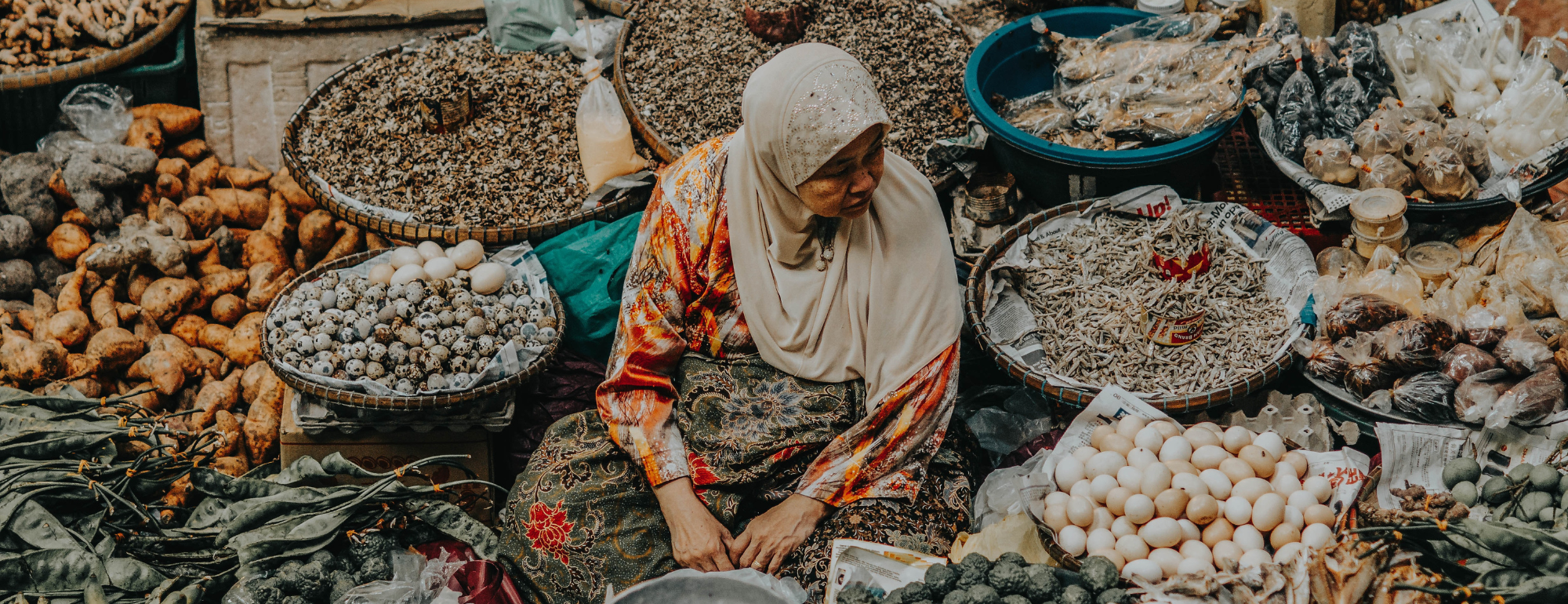International Women’s Day (March 8th) is a celebration of the social, economic, cultural, and political achievements of women around the world. In recognition of this day and this year’s theme, “Embrace Equity,” we want to highlight the important role women play in blue food systems and what actions improve equity in the sector. In October 2022, the Blue Food Assessment published the ‘Rights and representation support justice across aquatic food systems’ (Hicks et al. 2022) paper, which explored these intersections, analyzing the barriers to participation within blue food systems and how policy can steer us towards a more equitable future. The research team investigated economic, political and social barriers in the production and consumption policies of 173 countries to understand potential avenues for change and the research needed to get there.
Here, Christina Hicks and Zach Koehn, both first authors of the 2022 study, discuss the policy analysis process and what blue food communities, researchers and policymakers could learn from the findings. They also share critical actions that decision-makers can take to ensure principles of justice are recognized and included in both policy and practice.

Dr. Christina Hicks is a professor within the Political Ecology group at Lancaster University’s Environment Centre. She is an Environmental Social Scientist interested in the relationships individuals and societies form with nature; how these relationships shape people’s social, environmental, and health outcomes; and how they create sustainable livelihood choices.
Dr. Zach Koehn is an Early Career Fellow at the Stanford Center for Ocean Solutions. He focuses on the potential for these blue foods to contribute critical micronutrients to meet dietary requirements for people in different social and economic contexts. He also uses an environmental justice lens to identify inequities in the production and distribution of blue foods with respect to nutrition and livelihood security.

Your policy analysis included 306 laws and policies from 173 countries. How did you approach identifying economic, social, and political barriers across these different documents?
Koehn: First, we compiled production and consumption policies from the 173 countries in one big document database. Then, to figure out what economic, social and political barriers we should consider in our analysis, we worked with academic experts and practitioners from the field to identify keywords that represent these barriers, or that reflect strategies to overcome these barriers. For example, social barriers related to aspects of social identity such as gender, economic barriers often to aspects of wealth such as poverty, and political barriers included concepts that relate to participatory processes, such as representation. Once identified, we translated the keywords into five total languages to conduct our analysis. Rather than a one-to-one translation, keywords were translated based on the meaning of the word—sometimes, for example, there isn’t a straightforward translation from English to Spanish. Finally, we used a qualitative software called NVivo to count and compare the number of times keywords were referenced per page of each policy document.
Hicks: Conceptually, instead of identifying problems, we wanted to try to look at solutions, at what is working. Therefore, before we even started the policy analysis we looked for places that were doing better than expected given their local conditions. For example, we found formal education and wealth to be limiting factors in how much a country produced and consumed per capita. We, therefore, looked for places that despite low levels of wealth and formal education were still able to produce and consume more per capita and turned to the policies to see if these could explain the differences.
Was this a new analytical approach? How does the policy analysis in this paper compare to others in the field?
Hicks: Identifying places or countries that are doing better than expected to find local solutions in the way we did originates from nutrition research and has been applied in both business and conservation. We took a similar approach and applied it to the global aquatic food system. I expect a novel aspect is the scale of both the analysis and the system we applied this to. Although each place will need to develop context-specific policies, several clear patterns and principles emerge. For example, gender inequalities being clear barriers that, although often overlooked, some policies have helped address, suggests there are ways that international institutions can help in supporting more just aquatic food policies.
Koehn: The sheer number of policies we analyzed felt pretty new. Qualitative software is often used in text analysis, but typically researchers read through documents or use Google searches to analyze how well policies include certain keywords around, say, nutrition or conservation. This took more of a quantitative approach by using references per page. I think this approach will be more common in the future as a way to understand how governments are thinking about these concepts. However, this does not necessarily indicate how change is happening, because there’s a critical difference between recognizing a problem in a policy document and actually acting on it.
What did you find most surprising about the production and consumption policies?
Koehn: There was a big difference in how production and consumption policies reflected different types of barriers. We saw a tenfold increase in the number of references to social barriers in consumption policies, like dietary guidelines, than production policies, like fish harvest guidelines. Yet there are clearly social, political and economic barriers to production. Take gender-blind production policies, for example, which can fail to recognize the diverse roles women play in the blue food sector.
Hicks: Exactly. While many policies engaged with economic barriers, it was quite surprising how seldom policies include political representation and aspects of social difference, particularly gender. Even when they did, the policies could, rather than removing socially constructed barriers, place the burden for change on women. Although a policy may have been well-intentioned, much greater attention is needed in developing policies that address inequities and injustices so as not to replicate the injustices or inadvertently place blame on women.
Based on your analyses, could women in the blue food sector benefit when specifically included within food system policies? How can policies support more equal access to blue food benefits?
Koehn: Even taking the first step of recognizing the differing roles people play in blue food systems, often based on gender, and the roles that women envision playing in the sector, can help identify barriers. The next step is working toward policies that actually seek to address these barriers. That could include strategies to improve the potential for women to benefit from the roles they currently have as well as finding ways to expand those roles. Such redistributive approaches, like nutrition policies in the Philippines that recognize women who were nutritionally vulnerable and from poor families or communities experience barriers to resources, clearly acknowledge causes of injustice.
Hicks: The most effective efforts to address existing barriers start with an understanding of how and why these barriers exist. Social and cultural gender norms, that can be harmful, exist in all societies around the world and are deeply embedded in laws, policies, and practices. Undoing these is not a simple task and will face resistance, efforts therefore need to create a space for societies to question, recognize and reflect on harmful social norms, in order to bring about long-term change. For instance, a few nutrition policies explicitly discussed the responsibility of men and women in improving child feeding practices, other policies outlined how drivers such as poverty and gender discrimination create injustices before outlining redistributive approaches.
Some policies were also very explicit about the need for equity to be centered in decision-making—decision-making should be representative of communities impacted by policies, which includes women.
Could centering principles of justice and human rights in blue food policies overcome economic, social, and political barriers in practice? Are there examples of this type of change?
Hicks: Centering principles of justice and human rights is certainly a first step, however governments and companies need to be held accountable to these statements and individuals and civil society need to know how they can hold powerful actors to account, through for example, avenues of representation or in more severe cases litigation processes. Take the human right to food, for instance. Articulating that high-level concept—policies in Bangladesh and Gambia frequently start with language like ‘Nutrition is a basic human right’—allows for accountability measures that can give more weight to actions people want to drive on the ground. Thus policies are an important piece of the puzzle, they can help lay the foundation for more just societies, but practices need to be able to change on the ground.
Koehn: Policies that center human rights and principles of justice will, by definition, be trying to address economic, social, and political barriers. The larger issue is that the policies we analyzed represent the opinions of decision-makers, but not necessarily what’s actually happening on the ground. There’s a need to continue critical research that digs into whether actions are being taken by governments that purport to be centering justice within their policies at the national level and in their states or provinces.
Based on the analysis, what types of actions could decision-makers take at national or international levels to encourage more just policies?
Koehn: At the highest level, decision-makers need to recognize that these barriers exist in policy and practice. There are then opportunities to learn from countries that are ahead of the curve in terms of recognizing these principles to understand potential best practices.
Hicks: Our policy work, although global, focused on what was happening within national policies. However, many of the barriers discussed have their roots in historical and ongoing patterns of globalization and colonialism. It is therefore as important, if not more so, for international efforts to recognize the entrenched injustices that exist among nations, that undermine food security and nutrition, and that are only getting worse. Therefore, at both national and international levels, recognizing the structural drivers that exist among and within countries and making policies to redistribute resources is the first step. Second, it’s important to clearly articulate how decision-making processes and the bodies that inform these processes should be formed, ensuring a diversity of actors are involved and represented. And the third thing is centering human rights in policies—like the right to food and the right to a clean environment. We’ve made progress, but it’s critical to recognize that the whole world is facing shocks at the moment—from climate change, COVID-19, and the war in Ukraine—that are dramatically exacerbating existing inequalities. That makes it ever more important to take action.
